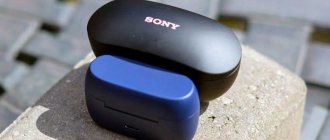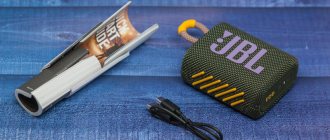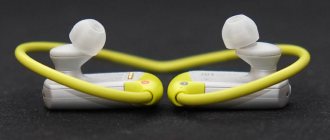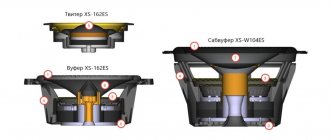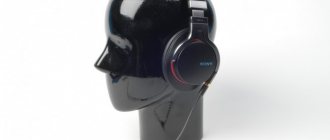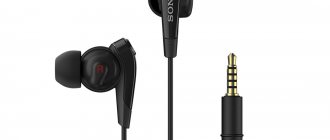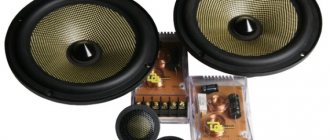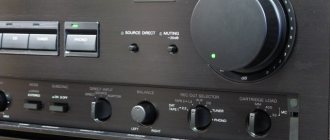SONY SS G7
Photo 1. Speaker Sony SS-G-7
Click on the picture to enlarge it
One of the SS-G models is a series of acoustics from SONY , the first system was released in 1976 and was produced for nine years. Three-way acoustics with bass reflex. The acoustics have the following parameters declared by the manufacturer:
Model: Three-way, with bass reflex Speakers used: LF cone type with a diameter of 38 cm MF dome type with a diameter of 10 cm HF dome type with a diameter of 3.5 cm Frequency range: 30-20000 Hz. Crossover frequencies: 550 Hz, 4.5 kHz Rated power: Pnom - 100 W Maximum power: Pmax - 200 W Sensitivity: 94 dB/W/m Impedance: 8 Ohms Level adjustment: HF and MF smooth Dimensions: height 940 x width 510 x depth 445 mm Weight: one speaker 48 kg
Photo 2. Sony SS-G-7 speaker with grill
Click on the picture to enlarge it
Among the acoustic features of the Sony SS G7, we can immediately note the front panel and the woofer. The front panel is milled to reduce sound wave reflections. Woofer with a powerful aluminum cast basket, diffuser holder and a powerful magnetic system. The optimal volume of the speaker housing was calculated and optimized on a computer.
Photo 3. Woofer
Click on the picture to enlarge it
Photo 4. Magnetic woofer system
Click on the picture to enlarge it
Using the NASTRAN program, a method for analyzing changes in the shape of a diffuser during high-speed movement, Sony calculates the speakers for the “G” series speaker . The woofer diffuser with a diameter of 35 cm is made of CARBOCON material, which is a paper pulp with the addition of carbon fibers, providing mechanical rigidity and vibration resistance. Part of the back side of the diffuser was coated with a special impregnation by hand. The magnetic system is manufactured using an Alniko type magnet, which provides a total gap flux of 214,000 Maxwell. The speaker basket is cast with stiffening ribs and a massive diffuser holder. Impedance: 7 Ohm. Maximum power: 100 Watt.
Photo 5. Midrange speaker
Click on the picture to enlarge it
Photo 6. Magnetic system of the midrange speaker
Click on the picture to enlarge it
The midrange speaker is no less unique, one might say a mixture of dome and cone diffusers; the diffuser is driven by a coil with a diameter of 7 cm and a powerful magnetic system, a magnet with a diameter of 12 cm. Impedance: 6 Ohm. Maximum power: 60 Watt.
Photo 7. HF speakers
Click on the picture to enlarge it
Photo 8. Magnetic tweeter system
Click on the picture to enlarge it
The tweeter with a titanium cone with a diameter of 3.5 cm and a textile suspension has an acoustic lens that increases the directivity pattern. The magnetic system is made using an Alniko type magnet. Impedance: 6 Ohm. Maximum power: 30 Watt. It should be noted that an Alniko type magnet has a magnetic force approximately 3 times higher than the magnetic force of ferrite magnets, but their production is expensive.
Photo 9. Block of tweeters and midrange speakers
Click on the picture to enlarge it
Photo 10. Magnetic systems of HF and midrange speakers
Click on the picture to enlarge it
The midrange and tweeter speakers are mounted on a powerful metal plate and combined into a separate unit. The speaker cabinet of the large bass reflex type is made with high quality and durability from 18mm chipboard with an internal spacer 30mm thick. Inside, the acoustics are well damped and soundproofed using spacers, mineral wool mats and accordion-curved rectangular felt sheets.
Photo 11. Speaker damping
Click on the picture to enlarge it
Photo 12. Spacer
Click on the picture to enlarge it
The filter block (crossover) is made on a printed circuit board and mounted on the rear wall of the speaker. The unique design of the low-pass filter is a coil with an inductance of 4.7 mH, wound with copper wire with a diameter of 1.8 mm and filled with a special resin.
Photo 13. Filter block
Click on the picture to enlarge it
Photo 14. Crossover
Click on the picture to enlarge it
The Sony SS G7 speakers have smooth adjustment of the levels of the high and mid ranges. The depth of smooth adjustment is 6 dB in each range.
Photo 15. Block for adjusting the HF and MF levels
Click on the picture to enlarge it
Photo 16. HF and midrange adjustments
Click on the picture to enlarge it
The acoustics sound beautiful and balanced, evenly throughout the entire audible frequency range, with good dynamics. Wide dynamic range allows you to listen to the quietest sounds of individual performers and the loudest sounds of entire orchestras without distortion. The Sony SS-G-7 acoustics sound beautiful and appeal to many listeners. Simply excellent acoustics with a sensitivity of 96 dB for a tube amplifier. The Sony SS G7 acoustics sound beautiful and good, and with high-quality transistor amplifiers.
Abakan 03/23/2014
- < Back
- Forward >
Comments
1
23
+11 #23 Techno_Trax 05/10/2017 16:32 Quoting master:
My regards. they painted their lips and sold it for good money, it’s beautiful. You need to be more careful when purchasing, listen well to familiar material.
This is generally an atas, but the main thing is that there will always be a buyer who will take it all for fabulous money... And he will be cruelly spoiled... I feel sorry for these people, in fact they take firewood.
It's the same with bicycles. I'm into bicycles. Quote +103 #22 master 05/10/2017 09:39 My respect. It also happens that it’s completely pale. I came once to evaluate the speakers of the 80s, they looked like they had just come from the factory, but the sound was like that of a 35-AC, thump-thump, thump-thump. One of the speakers somehow tried to sing, the second reproduced sounds. Everything became clear when the grills were removed, it turned out that the body was varnished on top, the woofer and midrange speakers were painted, and the front panel was also painted. In short, they painted the lips well and sold it for good money, it’s beautiful. You need to be more careful when purchasing, listen well to familiar material.
Quote
+7 #21 Techno_Trax 04/10/2017 16:43 I quote Gromov:
Thanks for your review of SONY SS G7. Now I know that I can safely buy SONY SS G7 and enjoy the sound. They did it before, but now where has it all gone?
The main thing is not to mess with the fawn rewind of the high frequencies, but this will be 90%%%% Quote
+11 #20 Gromov 04/08/2017 05:31 Thank you for the review of SONY SS G7. Now I know that I can safely buy SONY SS G7 and enjoy the sound. They did it before, but now where has it all gone?
Quote
+98 #19 master 04/06/2016 18:14 My respects. About the jammed dome, I don’t remember that the HF dome from the Sony G-7 jammed, it never happened. You have to straighten it often.
Quote
+122 #18 master 03/28/2016 22:53 My respects. I'm from Abakan, the capital of the Republic of Khakassia. I rewind the speakers a long time ago, I started with Soviet ones, in the distant 80s I bought S-90 speakers, the HF burned out, there was no place to buy it, and so it went. I'm going to write an article about rewinding speakers with measurements and comparisons between the factory speaker and the rewind one. Sometimes I upgrade and modify speakers mainly for myself. It seems like I didn’t send speakers to anyone, mostly to our music lovers, I’m rewinding, maybe someone was fussing. The factory has developed the technology for making speakers, but here you have to invent everything and do it yourself. It's not easy to disassemble the speakers, let alone rewind them and put them back together. Call the phone number above.
Quote
+5 #17 Techno_Trax 03/18/2016 21:33 Quoting master:
My regards. Rewinding a branded speaker is not as easy as it seems. YOU NEED TO TURN TO THOSE WHO CAN DO THE RIGHT THING, AND NOT WHERE IT’S CHEAPER AND FASTER.
Here I have nothing to add at all! Since everything is said correctly!
Are you by any chance from Khakassia?) It’s just that a person there once rewound a tweeter from a G7 for me, he did it well, but only slightly dented the dome. And everything is absolutely correct, there are a lot of inept hands. Before this, one guy rewound subs for me, he rewound subs all his life. Yes, I made the quality of the rewinding - above all praise. But the sound is not the same at all, everything was done without measurements and without testing. It played much worse than the original. Which city are you from? I'm from Saratov. I may need to rewind the speaker and I will know where to go. By the way, the G7 tweeter can be rewound with high quality, and it will play just a little worse than the original... Due to the fact that at the factory they were wound with an automatic machine and aluminum. Quote +115 #16 master 03/14/2016 1:38 pm Moreover, “Young Amateur” clearly did not turn to specialists for the repair of high-frequency speakers; in order for the Sony G-7 speakers to open up, you need a good amplifier and sound source. And Sony TA-AX500 amplifiers of the average price and quality category clearly will not reveal these speakers. The Onkyo integra m506r can and will sound good with these speakers. How often do we have praise and big debates around the lower price and quality category 2nd class, because... The market share of such equipment is 30-50%. The average price and quality category is 1st class, about 10-15%. And the share of high-quality equipment of class 0 is about 3-5%, well, very rare. I don't consider grade 3 and below (Swen, Microlab, BBK...).
Quote
+119 #15 master 03.14.2016 13:08 My respect. Rewinding a branded speaker is not as easy as it seems. I have been rewinding for a long time woofers, midranges and tweeters from speakers such as Sony G-7, Technics SB-7000, SB-6000, SB-8000, SB-6, SB-7, SB-8, MX-100D, SB-X5, Diatone DS-77, DS-1000, DS-2000, Yamaha NS-1000, etc. It is difficult to rewind correctly , sometimes they bring already rewound speakers by handless craftsmen, with them it is even more difficult because... you don’t know what wire, how many turns, how many layers, they were wound and how they were wound? Sometimes the coil is cut off. Recently I rewound a couple of high frequencies on a SONY G-7, a person bought branded ones (a Seas H881 was recommended by a friend) and installed them instead of his family ones, and brought his family ones for rewinding. I rewound both speakers, went to him to listen to what happened, we could hear a gap in the area where the midrange and high frequencies meet, the soloists sang inexpressively, sluggishly. After installing the original rewound ones, the speakers sounded as good and smooth as they should. YOU NEED TO TURN TO THOSE WHO CAN DO THE RIGHT THING, AND NOT WHERE IT’S CHEAPER AND FASTER.
Quote
0 #14 Young Amateur 03/04/2016 00:53 Oh friends, in December 2015 a couple came to the house! But one HF was 5% louder than the second, and when it hit 50 watts, it immediately went out (burnt out), it was scorched, and it started... I put the rewound speakers in its place and was already thinking about installing other analog HFs, I was incredibly exhausted in the search, but exactly a year later I found myself an original HF! I installed it and now my speakers have no price. The fact is that it is impossible for anyone to rewind the HF the way it was originally... It has a flat aluminum winding. Moreover, the HF in the G7 is the weakest link, they are 6 Ohms and 30W, which is why they often burn out if about 100 watts of sound is supplied to the speakers for a long time. About the sound of the G7: Before this I listened to a friend’s YAMAHA FX-3, Diatone DS3000, ONKYO Monitor 2000X, ONKYO Monitor 2001. All of them seem to be a level better. But to be honest, I liked the sound of the G7 the most, it doesn’t hurt the ear and the stage barely reaches those speakers... And that’s cool. The fact is that it is very difficult to make huge speakers sound like good headphones (someone already gave an example with headphones), but they play like high-quality closed headphones. Everyone who wrote about the intelligibility of sound and words is all true. As for softness, they are not that soft. Really nice clear sound with proper, powerful bass. (I personally did not have enough bass in most monitors) the G7 is completely fine with it. You feel the big drum nearby... Any amplifier will do, really, even a 10-watt one.... These are not lies. But I’ll tell you a certain pattern: I listen to them with a Sony TA-AX500 and an Onkyo integra m506r, and to be honest, I like listening to them with a Sony amplifier even more. Apparently they are brothers. Brighter highs and mids and more serious bass. But really, even any old Vega will do. And keep an eye on the HF speakers.. Alas, 50% of the Internet is just high-quality HF speakers. By the way, they also play not bad - they passed... But there is nothing better than the original. The high frequencies in the G7 are very bright and long, giving all the colors to the sound of the G7. If anyone is against something, please write.
Quote
1
23
Update list of comments RSS feed of comments for this entry
Add a comment
Video
As you know, Sony cameras are now more popular precisely because of their video component. Don’t come to me for it - I don’t know how to shoot a video and understand it even less than my amateurish knowledge of photography. However, I realize that the camera will be good, for example, for travel bloggers who film themselves handheld: the body is very light and compact. Especially if the right lenses are selected, which, as you know, Sony is far from small:
Sony α7C + Sony Carl Zeiss Sonnar T*135mm f/1.8 ZA. Photo: Alexey Bulgakov / Wylsacom Media
For video savvy people considering purchasing the Sony α7C, there are three things to know:
- The camera cannot shoot 10-bit video. Even via HDMI. Maximum 4:2:2 8-bit. That is, you will not be able to expand the color correction of the video to its full height;
- The 4K camera shoots no more than 30 frames per second;
- The camera only has one SD card slot, meaning you won't be able to backup your footage.
For color correction, the camera can shoot video in S-Log2 and S-Log3, and to expand the dynamic range, you can shoot video in Hybrid Log-Gamma.
But with my inability to shoot a video, the demo video came out like this. There is no processing or color correction here:
Control screen and viewfinder
The touch screen on the back of the Sony A7 IV can now rotate up and down, making it easier to shoot from low heights.
The panel resolution is 1.03 million dots and the aspect ratio is 3:2. The menu structure remains almost the same as on the A7S III and A1, so switching from these models to the A7 IV will be easy.
As with other modern cameras, many menu items and controls can be customized.
On the top side of the A7 IV is an OLED viewfinder with a resolution of 3.68 million dots and a magnification of 0.78x. The image clarity is much higher than on the A7 III with its 2.68 million dots, and is not inferior to competitors in the price segment.
Bottom line
Need a camera for your travel blog? It's probably worth considering the α7C, the world's smallest full-frame camera.
All reviewers say this: the camera will be very convenient when traveling: light and compact. And it, like any other Sony, will be a reliable workhorse.
Illustration: Svetlana Chuvileva / Wylsacom Media
The Sony α7C doesn't need to be an inspiring camera. This is a working device with which professionals will create content of the required quality.
Of course, if you need 10-bit video, then you should either take a closer look at the company’s older models, or look for a workhorse among its competitors.
Of course, many may be very confused by the price, due to the sad reality for the ruble and Russians: the officials sell the “carcass” for 157 thousand rubles, and a set with the Sony FE 28–60 mm f/4–5.6 kit lens is sold for 175 thousand rubles.
If you choose from sets, then first you need to decide which lenses you need. For example, Sony recently revealed the FE 40mm f/2.5 G - I'd really like to shoot with it as my favorite focal length is somewhere between 35 and 50mm.
And focal lengths around 43 mm for a full frame are considered ideal due to the diagonal of the matrix, which makes the proportions close to the picture that our eyes see. And considering that this FE 40mm f/2.5 G is also very compact, I would gladly take this lens with the Sony α7C on any trip.
All buyers of Alpha products in Sony Center brand stores will have an extended warranty of 3 years. If you have doubts about the purchase, a seven-day test drive is possible. We offer our readers a discount using the promotional code AlphaWylsa.
⇡#Shooting at high ISO
The Sony a7C's light sensitivity range is ISO 100–51,200, expandable down to ISO 50 and up to ISO 204,800.
The Auto ISO system allows you to specify the lower and upper limits for ISO, as well as the minimum shutter speed you want to maintain. This threshold can be defined either as a fixed shutter speed value, or as a value relative to the current focal length: it can be equal to 1 / [Focal Length], or be proportionally longer or shorter. Auto ISO is available in manual exposure mode, in both photo and video modes.
It is logical to expect that the noise level of the new product will be the same as that of the Sony a7 III, because the main hardware has not changed, and only minor factors such as camera heating can affect the result.
Let's look at some practical examples shot at high ISOs, and then move on to the test scene. All JPEGs are taken with standard noise reduction.
ISO 2000 – the picture is “smooth” in both RAW and JPEG.
| Left - in-camera JPEG, right - RAW, converted with default settings | ||
The next photo was taken at ISO 5000. It also looks absolutely decent. In RAW, noise is noticeable if you zoom in, but it is still quite subtle. In JPEG, the noise reduction practically erased them - this made the picture a little blurry, but again this is only visible if you zoom in on the image. When viewed on a large monitor, everything looks good.
| Left - in-camera JPEG, right - RAW, converted with default settings | ||
At ISO 6400 the overall picture is about the same.
| Left - in-camera JPEG, right - RAW, converted with default settings | ||
But this scene was shot at ISO 8000: here the noise is clearly visible in the sky in RAW, whereas in JPEG the sky is rather simply uneven.
| Left - in-camera JPEG, right - RAW, converted with default settings | ||
At the same time, the scene shot with a darker sky at ISO 12800 also looks quite high quality
| Left - in-camera JPEG, right - RAW, converted with default settings | ||
And now - test frames:
| ISO 50 | ||
| ISO 100 | ||
| ISO 200 | ||
| ISO 400 | ||
| ISO 800 | ||
| ISO 1600 | ||
| ISO 3200 | ||
| ISO 6400 | ||
| ISO 12800 | ||
| ISO 51200 | ||
| ISO 102400 | ||
| ISO 240800 | ||
Well, the Sony a7C shows really good performance. Not only the upper value (ISO 51,200), but also the extended value (ISO 102,400) can be called acceptable for shooting - with allowance, of course, for the loss of detail and deterioration in color rendition. The ISO value of 204,800 is suitable for formally capturing something in a photo, but due to the abundant colored noise and the general blurriness of the picture, it is hardly suitable for artistic photographs.
Photo quality
The Sony A7 IV camera has noticeably improved the quality of photo shooting.
The resolution has increased, the pictures are expectedly sharper, and the quality in low light is higher than that of the Sony A7S III. When shooting in the dark, there is virtually no noise until ISO 12,800, and with proper exposure, photos remain “clean” until ISO 25,600. After that, the noise becomes too noticeable.
It is important that Sony has worked on the colors: there is no longer a shift towards green shades, all colors are natural and very accurate. In terms of photo quality, the A7 IV is one of the best cameras on the market.
⇡#Shooting in RAW, dynamic range
It is difficult to clearly judge whether Sony’s new product is aimed primarily at photographers who shoot in JPEG or RAW, but it is obvious that the RAW format remains preferable for critical shooting or shooting with difficult lighting - and it is this format that fully reveals the camera’s potential.
As usual with Sony cameras, the user can shoot either uncompressed RAW (which is what I did when shooting for the review) or lossily compressed, while competitors from other manufacturers often have a RAW format with lossless compression.
I edited the review photos in Adobe Camera Raw. I chose several contrasting scenes as examples. The purpose of processing is to bring the photo into balance, to better bring out the highlights and brighten the shadows.
| On the left - in-camera JPEGs, on the right - RAW, converted with settings to taste | ||
The dynamic range of the a7C is very decent. Both lights and shadows “stretch” quite well.
Application
You can connect to the Sony α7C using your smartphone. There's an app called Imaging Edge Mobile for that. With it, your smartphone becomes a remote screen and you can, for example, film yourself. I shot a video with a bass guitar using this application.
The interface is simple:
It can also be used in horizontal orientation:
The application is excellent: no slowdowns, image transfer freezes are very rare. But there is one problem:
It occurs whenever you try to connect to a camera that you have already connected to. Therefore, you have to do it again via the QR code. To do this, go to the menu in the “Network1” section and select “Control. with smartphone":
In the window that opens, select “Connection”:
Although if you have a Sony smartphone with NFC, then the connection will probably be much easier: just bring the phone to a special mark on the camera.
Autofocus and continuous shooting
Sony mirrorless cameras are known for their fast autofocus and smart features, and the Sony A7 IV is no exception.
Many functions have been added using AI (artificial intelligence), which makes everything work flawlessly with virtually no user interaction. Unlike the A7 III, face, eye and body tracking occurs not only when shooting people, but birds and animals.
The camera itself finds the eyes, face or body of the subject and continues to track it even if it turns or moves out of frame. You just need to select the desired object on the screen, and smart algorithms will take care of the rest.
True, there are some shortcomings here too. The 33 MP CMOS sensor is back-illuminated, but does not have a “layered” structure like the A1, so the continuous shooting speed is lower. It is 10 fps in Hi+ mode and 8 fps in Hi mode.
These are still excellent figures considering the resolution has increased by 50%. But not in comparison with other models - the Sony A1, for example, shoots at 30 fps in a 50 megapixel resolution.
The memory buffer is large - you can shoot up to 1000 uncompressed frames in RAW. If you use CFexpress Type A cards from Sony or ProGrade, you won't have to worry about buffer overflows at all.
The A7 IV's continuous shooting has one drawback - it creates a rolling shutter effect. To get rid of this problem, the camera will have to be held firmly, and the subject should not move too quickly. Otherwise, the frame may be hopelessly damaged.
Autofocus works great not only during continuous shooting, but also with many objects in the frame in not the best lighting. The A7 IV does well with automatic exposure and white balance adjustments.
Design and construction
The Sony A1, A7S III and A7R IV were significantly different from their predecessors in terms of design, and the same can be said about the Sony A7 IV.
But the grip remains large and comfortable, so you never have the feeling that you might drop the camera - even if you put a huge lens on it. The model weighs 699 grams, although the weight of the A7 III was 650 grams, in addition, the body has become 7 mm thicker.
Compared to the more expensive A1, the updated A7 IV lacks dials for adjusting autofocus and shooting modes.
The video recording key has moved from the back to the top, making it more convenient to press. The rest of the layout has not changed. The buttons and dials have become more responsive when used, and the joystick is more convenient to control.
